|
|
|
|
|
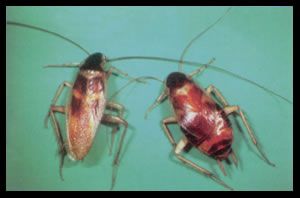
|
Brownbanded Cockroach
Supella longipalpa
Adults about 3/4" long, males much slimmer than females. Identified by 2 broad brown bands crossing the thorax. Egg capsule small, average 15 eggs, glued to hidden surfaces by female. Egg to mature adult in about 6 months. Individuals may be found throughout structure, and not as dependent on moisture as other species. |

|
American Cockroach
Periplaneta americana
Largest urban pest Cockroach - up to 2" long. Adults reddish brown with yellow margined pronotum. Average 15 eggs per capsule, over 1 year to the mature adult. Prefer warm, damp areas - sewers, basements - common outdoors. |

|
German Cockroach
Blattella gemanica
Adults 2/4" long, tan with 2 black longitudinal marks on pronotum. Average 3 eggs per capsule which is carried by the female until ready to hatch. Only 3 months to the mature adult. Most common structural cockroach, a non-flyer carried into structures by man. |
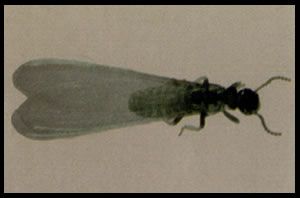
|
Subterranean Swarmer
Dark brow to black. Swarm during the day typically during the morning following a warm rain in the spring |
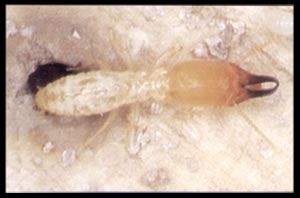
|
Subterranean Soldier
Head rectangular. Mandibles lack teeth |
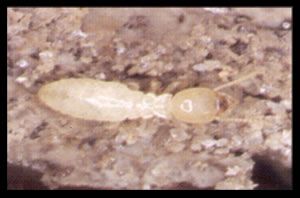
|
Subterranean Worker
Eat mostly spring wood. Typical mature colony may consist of 60,000. Colony could consume 2-1/3 linear feet of pine 2"x4" in 1 year |
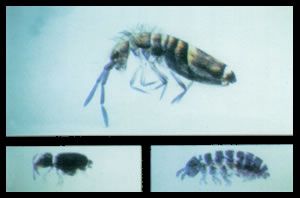
|
Springtails
Order Collembola
Adults only about 1/16" long, black gray or silvery in color. Attached to the tip of abdomen is a long appendage (the furcula) which is used to snap insect into the air when disturbed. Attracted to water, common in damp areas. Called "Snow Fleas" when occuring in early spring on patches of snow. |
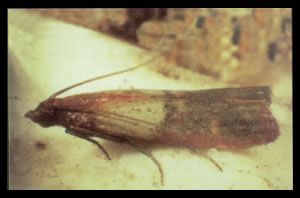
|
Indian Meal Moth
Plodia Interpunctella
Adult moths with wings bicolored - light inner half, coppery outer half. Larval color carries from cream to pink to greenish, no spots along body. Nocturnal adults avoid light. Up to 400 eggs laid on almost any stored food product, particularly nuts and dried fruit. Larva often leave food source to wander long distances to pupate.
|
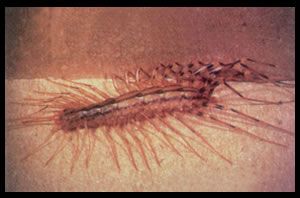
|
House Centipede
Scutigera coleoptrata
Adults up to 2" long, with extremely long legs - 15 pairs - last pair very long. Poison glands present, biting possible on humans, but problems slight. Very fast moving creatures, occuring commonly in structures where they feed on insects
|

|
Millipede
Class Diplopoda
Adults up to 5" long, may live 8 years as immature and adult. Two pairs of legs per segment, rounded body shape, slow moving vegetarians. Many give off toxic secretions or unpleasant odors when disturbed. Occasionallyextremely large infestations occur in structures.
|
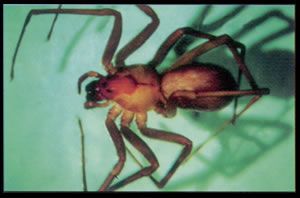
|
Brown Recluse Spider
Loxosceles Reclusa
Adults medium sized, light brown/tan, and with distinct "fiddle" marking on cephalothorax. Eye arrangement distinctive, as 3 pairs (6 eyes total) arranged in a row across front. Venom is "haemolytic", destroying skin tissues and healing slowly. A "shy" spider which avoids activity, but hides in clothing in closets, furniture, other out of the way places. Up to 50 eggs per sac, up to a year to adult, may live several years.
|
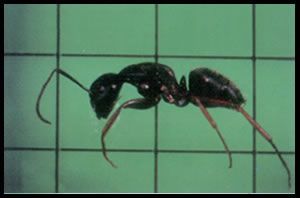
|
Carpenter Ants
Camponotus spp.
Adults up to 1" long, colors vary from tan to reddish to black. Single-node on pedicel, thorax without spines and with an even, rounded profile dorsally. Commonly establish satellite nests in structures connected to major nest in soil. Do not eat wood, but may create large cavities in wood for nest.
|
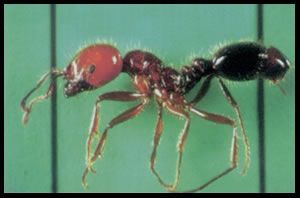
|
Southern Fire Ant
Solenopsis xyloni
Adults yellowish to red and black, up to 1/4" long. Two nodes, no spines on thorax, well developed stinger. Dirt mounds indicate nests in soil, rotten wood, under boards, concrete.
|
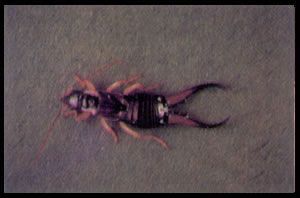
|
Earwig - Family Forficulidae
European Earwig - Forficula auricularia
Adults dark colored with pale legs, well developed wings folded under small wing covers. Forcepts or pinchers, are the cerci, used in defense as well as for capturing food. Female lays up to 50 eggs, cares for them and the young after hatching. Food is primarily plant material and other insects, including termites.
|
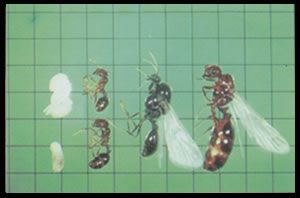
|
Red Imported Fire Ant
Solenopsis invicta
Adults red and black, very hairy, up to 1/4" long. Two nodes on pedicel, no spines on thorax. Nests in soil with up to 250,000 ants in a nest, dirt mounded up on surface. Workers are fierce stingers, living up to 180 days.
|
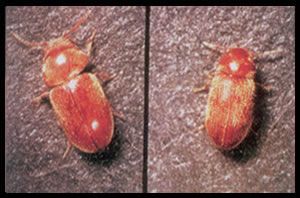
|
Drugstore Beetle - Stegobium paniceum
Cigarette Beetle - Lasioderma serricorne
Adults very small, brown to reddish, with the head tucked under the overhanging pronotum. Cigarette Beetle shinier, more rounded, with antennal segments all small and equal in size. These attack the widest range of stored foods and tobacco -favorites are spices, baked goods, pet foods. Life cycle completes in about 1 month, with both larva and adult actively feeding.
|
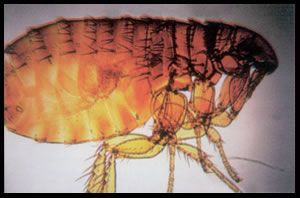
|
Fleas - Order Siphonaptera
Cat Flea - Ctenocephalides felis
Adults very small, wingless, dark brown to black, compressed laterally. Larva legless, worm-like, hairy. Eggs laid on the host, female may lay several hundred in her lifetime. Larva a scaven- ger feeding on debris in carpet or outdoors, including dried blood. Extremely important vector of diseases, and cause of discomfort and allergies.
|

|
Silverfish
Ctenolepisma sp.
Gradual metamorposis leading to adults about 1/ 2" to 3/4" long, scaled, color from gray/brown to silver, carrot shaped, long antenna. Very fast runners, common in wall voids and attics, brought in in wood products, papers, firewood, or entering by themselves. Feed on both carbohydrates and protein -meats, flours and cereals, bond papers, book bindings, paper pastes. Presence detected by small, black, pepper-Iike fecal droppings.
|
-300px-Apr-5-2004-15-13-46.jpg)
|
Varied Carpet Beetle
Anthrenus verbasci
Adults small, somewhat flattened and oval in shape. Colors black, white, and brown, mottled and variable. Only larvae damage animal materials such as fur, skins, wool, felt, insects. Larva brown, very hairy, head end narrow, posterior widened with 3 tufts of long hairs. Commonly infest any man-made object of animal origin, insect and bird nests. Larval period normally lasts almost a year. Adults feed on flowers, larvae very active in wandering about.
|
|
|
|
|
|
 |



